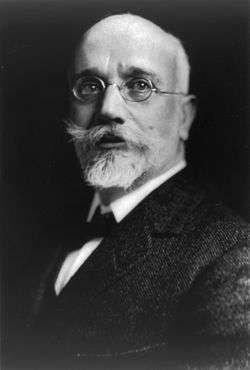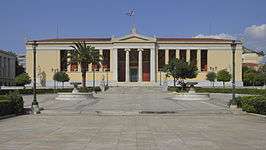National and Kapodistrian University of Athens
| Εθνικόν και Καποδιστριακόν Πανεπιστήμιον Αθηνών | |
|
Seal of the National and Kapodistrian University of Athens | |
| Latin: Universitas Atheniensis | |
| Type | Public |
|---|---|
| Established | May 3, 1837 |
| Rector | Meletios–Athanassios Dimopoulos |
Academic staff | 1,974 |
Administrative staff | 1,316 |
| Students | 104,000 (2014)[1] |
| Undergraduates | >50,000 |
| Location | Zografou, Greece |
| Campus | Urban, suburban |
| Newspaper | To Kapodistriako |
| Colours | Blue and White |
| Website | Official website (in English) |
 | |
The National and Kapodistrian University of Athens (NKUA;[2] Greek: Εθνικόν και Καποδιστριακόν Πανεπιστήμιον Αθηνών, Ethnikón kai Kapodistriakón Panepistímion Athinón),[lower-alpha 1] usually referred to simply as the University of Athens (UoA), is a public university in Zografou, a suburb of Athens, Greece. It has been in continuous operation since its establishment in 1837 and is the oldest higher education institution of the modern Greek state and the first contemporary university in the Eastern Mediterranean. Today it is one of the largest universities by enrollment in Europe, with 104,000 (2014) registered students.[1] In 2012 it was ranked in the positions 501–550 among the best universities in the world, according to the index of QS World University Rankings, as well as according to the evaluation of Academic Ranking of World Universities (ARWU).
History
Founding and expansion
The University of Athens was founded on May 3, 1837, by King Otto of Greece (in Greek, Othon) and was named in his honour Othonian University (Οθώνιον Πανεπιστήμιον). It was the first university in the liberated Greek state and in the surrounding area of Southeast Europe as well. It was also the second academic institution after the Ionian Academy. This fledging university consisted of four faculties; Theology, Law, Medicine and Arts (which included applied sciences and mathematics). During its first year of operation, the institution was staffed by 33 professors, while courses were attended by 52 students and 75 non-matriculated "auditors".

It was first housed in the residence of architects Stamatios Kleanthis and Eduard Schaubert, on the north slope of the Acropolis, in Plaka, which now houses the Museum of the University. In November 1841 the university relocated on the Central Building of the University of Athens, a building designed by Danish architect Christian Hansen. He followed a neoclassical approach, "combining the monument's magnificence with a human scale simplicity" and gave the building its H-shape.[3] The building was decorated by painter Carl Rahl, forming the famous "architectural trilogy of Athens", together with the building of the National Library of Greece (left of the university) and the building of the Athens Academy (right of the university). Construction began in 1839 in a location to the north of the Acropolis. Its front wing, also known as the "Propylaea", was completed in 1842–1843. The rest of the wings' construction, that was supervised at first by Greek architect Lysandros Kaftantzoglou and later by his colleague Anastasios Theofilas, was completed in 1864. The building is nowadays part of what is called the "Athenian Neoclassical Trilogy".[3]
The Othonian University was renamed to National University (Εθνικόν Πανεπιστήμιον) in 1862, following events that forced King Otto to leave the country. It was later renamed to "National and Kapodistrian University of Athens" to honour Ioannis Kapodistrias, the first head of state of the independent modern Greek state.
A major change in the structure of the University came about in 1904, when the faculty of Arts was divided into two separate faculties: that of Arts (Σχολή Τεχνών) and that of Sciences (Σχολή Επιστημών), the latter consisting of the departments of Physics and Mathematics and the School of Pharmacy. In 1919, a department of chemistry was added, and in 1922 the School of Pharmacy was renamed a Department. A further change came about when the School of Dentistry was added to the faculty of medicine.
Between 1895 and 1911, an average of 1,000 new students matriculated each year, a number which increased to 2,000 at the end of World War I. This resulted in the decision to introduce entrance examinations for all the faculties, beginning for the academic year 1927–28. Since 1954 the number of students admitted each year has been fixed by the Ministry of Education and Religion, by proposal of the faculties.
Modern history
From 1911 until 1932 the university was separated into the Kapodistrian University (the humanities departments; named after Ioannis Kapodistrias) and the National University (the science departments). In 1932, the two separate legal entities were merged into the National and Kapodistrian University of Athens.
During the 1960s construction work began on the University Campus in the suburb of Ilissia, which houses the Schools of Philosophy, Theology and Sciences.[4]
In 2013, the University Senate made the decision to suspend all operations in the wake of the Ministry of Education and Religious Affairs cutting 1,655 administrative jobs from universities around the country. In a statement, the University Senate said that "any educational, research and administrative operation of the University of Athens is objectively impossible".[5][6]
Faculties and departments
The University of Athens is divided into schools, faculties and departments as follows. The naming is nοt consistent in English for historical reasons, but in Greek the largest divisions are generally named "σχολές" (schools) and are divided in "τμήματα" (faculties), furthermore subdivided in "τομείς" (departments).[7]
- School of Theology
- Faculty of Social Theology
- Faculty of Theology
- School of Philosophy
- Faculty of Philology
- Faculty of History and Archaeology
- Faculty of Philosophy, Pedagogy and Psychology
- Faculty of Psychology
- Faculty of English Language and Literature
- Faculty of French Language and Literature
- Faculty of German Language and Literature
- Faculty of Italian Language and Literature
- Faculty of Spanish Language and Literature
- Faculty of Slavic Studies
- Faculty of Music Studies
- Faculty of Theatre Studies
- School of Law
- Faculty of Law
- School of Economics and Political Sciences
- Faculty of Communication and Mass Media Studies
- Faculty of Economic Studies
- Faculty of Political Science and Public Administration
- Faculty of Turkish and Modern Asian Studies
- School of Sciences
- Faculty of Physics
- Faculty of Biology
- Faculty of Geology and Geoenvironment
- Faculty of Chemistry
- Faculty of Mathematics
- Faculty of History and Philosophy of Science (formerly Faculty of Methodology, History and Theory of Science)[9]
- Faculty of Informatics and Telecommunications
- School of Health Sciences
- School of Education
- Faculty of Physical Education and Sport Science
- Faculty of Primary Education
- Faculty of Early Childhood Education
Academic evaluation
An external evaluation of all academic departments in Greek universities will be conducted by the Hellenic Quality Assurance and Accreditation Agency (HQAA) in the following years.[12]
- School of Theology
- School of Philosophy
- Department of History and Archaeology (2010)[15]
- Department of Philology (2013)[16]
- Department of Philosophy, Pedagogy and Psychology (2013)[17]
- Department of English Language and Literature (2011)[18]
- Department of French Language and Literature (2010)[19]
- Department of German Language and Literature (2014)[20]
- Department of Spanish Language and Literature (2013)[21]
- Department of Italian Language and Literature (2014)[22]
- Department of Theatre Studies (2014)[23]
- Department of Music Studies (2014)[24]
- School of Law
- Department of Law (2013)[25]
- School of Sciences
- Department of Mathematics (2012)[26]
- Department of Physics (2013)[27]
- Department of Chemistry (2012)[28]
- Department of Biology (2013) [29]
- Department of Geology and Geoenvironment (2012)[30]
- Department of Informatics and Telecommunications (2011)[31]
- Department of Methodology, History and Theory of Science (2010)[32]
- School of Health Sciences
- School of Economics and Political Sciences
- School of Education
Campuses

The main campus is at Ano Ilisia (Zografou). There the faculties of Science, Theology and Philosophy are situated. The faculty of Life Sciences is located at Goudi and the faculty of Physical Education and Sports Science is located at Dafni. The faculties of Media, Education, Economics, Law and Public Administration are housed in various buildings near the centre of Athens, along with various administration facilities. University administration was housed initially in a historical neoclassical building near the center of Athens on Panepistimiou Street, but was relocated at the main university campus later.
Campus location Schools Independent faculties Ano Ilisia School of Science School of Theology School of Philosophy Faculty of Methodology, History and Theory of Science Goudi School of Health Sciences Centre of Athens School of Law, Economics
and Political SciencesFaculty of Communication and Mass Media Studies Faculty of Primary Education Faculty of Early Childhood Education Faculty of Slavic Studies Faculty of Turkish and Modern Asian Studies Dafni Faculty of Physical Education and Sport Science
Research
Research in the University of Athens includes almost all research interests. Such research in the university is associated with that conducted by the hospitals and research institutes of the metropolitan area, including the National Research Center for Physical Sciences Demokritos, the National Research Foundation (EIE), the National Observatory of Athens, the Hellenic Pasteur Institute, the Alexander Fleming Biomedical Sciences Research Center, the Athens High Performance Computing Laboratory, the National Centre for Marine Research (NCMR) and the Foundation for Biomedical Research of the Academy of Athens (BRFAA). Research conducted in the institutes of the metropolitan area of Athens accounted for more than 50% of the ISI-indexed scientific publications coming from Greece in 2004. The Department of Informatics and Telecommunications has been ranked continuously among the 100 most important research institutes in the field of Computer Science, according to Academic Ranking of World Universities (ARWU).[45]
Notable alumni
Throughout its history, a sizeable number of University of Athens alumni have become notable in many varied fields, both academic and otherwise. Moreover, 2 Nobel prize-winners have studied or taught at Athens, with both their prizes being in Literature.
Politics
15 Greek prime ministers and three Greek presidents (Konstantinos Karamanlis served as both) have studied at the University of Athens, including Charilaos Trikoupis, Eleftherios Venizelos, Georgios Papandreou, Andreas Papandreou, Konstantinos Karamanlis, Karolos Papoulias, and most recently interim prime minister Vassiliki Thanou-Christophilou. Also, Constantine II, the last monarch of Greece, and Nicos Anastasiades, the current president of Cyprus, attended the university.
The University of Athens has also been home to a large number of other politicians, who were primarily Greek or Cypriot, such as Dora Bakoyannis, Kyriakos Mavronikolas, Georgios Alogoskoufis and Fofi Gennimata.
Science
- Gerasimos Danilatos, physicist, inventor of the ESEM
- Sophia Frangou, psychiatrist
- John P. A. Ioannidis (DSc, 1996 and MD 1990), professor and medical researcher[46]
- Fotis Kafatos, biologist
- Michael N. Katehakis, applied mathematics and operations research
- Nikos Logothetis, neuroscientist
- Evangelos Moudrianakis, biologist
- Dimitri Nanopoulos, physicist
- Costas Soukoulis, physicist
- Georgios Papanikolaou, doctor, inventor of the Pap test
- Panayotis Varotsos, physicist
- Dimitrios Trichopoulos, cancer epidemiologist
Literature and philosophy
- Giorgios Seferis, Nobel laureate (1963), poet[47]
- Odysseas Elytis, Nobel laureate (1979), poet[48]
- Cornelius Castoriadis
- Nikos Kazantzakis
- Emmanuel Kriaras
- Helene Ahrweiler
- Christos Kalpakidis
Other
- Saint Nectarios of Aegina
- Apostolos Santas
- George Lucas Adamopoulos, founder of the only school in the Philippines founded by Greeks, Adamson University in Manila
- Panagiotis Pikrammenos, judge and caretaker prime minister
See also
- Athens University Museum
- Faculty of Geology and Geoenvironment (University of Athens)
- List of University of Athens alumni
- Education in Greece
- List of universities in Greece
- List of research institutes in Greece
- List of modern universities in Europe (1801–1945)
- THES - QS World University Rankings (from 2010 two separate rankings will be produced by the Times Higher Education World University Rankings and the QS World University Rankings)
Notes
- ↑ Labelled and stylized in new logos as HELLENIC REPUBLIC National and Kapodistrian University of Athens.
References
- 1 2 National and Kapodistrian University of Athens – A Self-Portrait
- ↑ NKUA – National and Kapodistrian University of Athens – European Commission
- 1 2 "University of Athens – Archaeology of the City of Athens". National Hellenic Research Foundation (In Greek). Retrieved 6 October 2014.
- ↑ "History and Perspectives". uoa.gr. Retrieved 2010-06-10.
- ↑ Korologou, Maria (September 23, 2013). "University of Athens, NTUA Suspend Operations". GreekReporter. Retrieved 2015-01-29.
- ↑ Helena Smith (September 25, 2013). "Austerity measures push Greek universities to point of collapse". The Guardian.
- ↑ "Schools and Faculties". uoa.gr. Retrieved 2010-06-10.
- ↑ "Tο υπερσύγχρονο κτήριο της Nομικής Σχολής" (in Greek). kapodistriako.uoa.gr. 2006-02-01. Retrieved 2009-03-14.
- ↑ NKUA: PHS
- ↑ Πανεπιστημιακή Λέσχη 80 χρόνια προσφοράς στους φοιτητές. To Kapodistriako (in Greek). kapodistriako.uoa.gr. 2002-04-15. Retrieved 2015-03-04.
- ↑ "Facilities & Student Life". Uoa.gr. Retrieved 2010-12-23.
- ↑ "Hellenic Quality Assurance and Accreditation Agency". Adip.gr. Retrieved 2015-03-04.
- ↑ "Final Report – Department of Theology, NKUA, 2013" (PDF). Adip.gr. Retrieved 2015-03-04.
- ↑ "Final Report – Department of Social Theology, NKUA, 2013" (PDF). Adip.gr. Retrieved 2015-03-04.
- ↑ "Final Report – Department of History and Archaeology, NKUA, 2010" (PDF). Adip.gr. Retrieved 2015-03-04.
- ↑ "Final Report – Department of Philology, NKUA, 2013" (PDF). Adip.gr. Retrieved 2015-03-04.
- ↑ "Final Report – Department of Philosophy, Pedagogy and Psychology, NKUA, 2013" (PDF). Adip.gr. Retrieved 2015-03-04.
- ↑ "Final Report – Department of English Language and Literature, NKUA, 2011" (PDF). Adip.gr. Retrieved 2015-03-04.
- ↑ "Final Report – Department of French Language and Literature, NKUA, 2010" (PDF). Adip.gr. Retrieved 2015-03-04.
- ↑ "Final Report – Department of German Language and Literature, NKUA, 2014" (PDF). Adip.gr. Retrieved 2015-03-04.
- ↑ "Final Report – Department of Spanish Language and Literature, NKUA, 2013" (PDF). Adip.gr. Retrieved 2015-03-04.
- ↑ "Final Report – Department of Italian Language and Literature, NKUA, 2014" (PDF). Adip.gr. Retrieved 2015-03-04.
- ↑ "Final Report – Department of Theatre Studies, NKUA, 2014" (PDF). Adip.gr. Retrieved 2015-03-04.
- ↑ "Final Report – Department of Music Studies, NKUA, 2014" (PDF). Adip.gr. Retrieved 2015-03-04.
- ↑ "Final Report – Department of Law, NKUA, 2013" (PDF). Adip.gr. Retrieved 2015-03-04.
- ↑ "Final Report – Department of Mathematics, NKUA, 2012" (PDF). Adip.gr. Retrieved 2015-03-04.
- ↑ "Final Report – Department of Physics, NKUA, 2013" (PDF). Adip.gr. Retrieved 2015-03-04.
- ↑ "Final Report – Department of Chemistry, NKUA, 2012" (PDF). Adip.gr. Retrieved 2015-03-04.
- ↑ "Final Report – Department of Biology, NKUA, 2013" (PDF). Adip.gr. Retrieved 2015-03-04.
- ↑ "Final Report – Department of Geology and Geoenvironment, NKUA, 2012" (PDF). Adip.gr. Retrieved 2015-03-04.
- ↑ "Final Report – Department of Informatics and Telecommunications, NKUA, 2011" (PDF). Adip.gr. Retrieved 2015-03-04.
- ↑ "Final Report – Department of Methodology, History and Theory of Science, NKUA, 2010" (PDF). Adip.gr. Retrieved 2015-03-04.
- ↑ "Final Report – Department of Medicine, NKUA, 2014" (PDF). Adip.gr. Retrieved 2015-03-04.
- ↑ "Final Report – Department of Medicine – Postgraduate Programmes, NKUA, 2014" (PDF). Adip.gr. Retrieved 2015-03-04.
- ↑ "HQAA Final Report – Department of Pharmacy, NKUA, 2013" (PDF). Adip.gr. Retrieved 2015-03-04.
- ↑ "HQAA Final Report – Department of Dentistry, NKUA, 2010" (PDF). Adip.gr. Retrieved 2015-03-04.
- ↑ "HQAA Final Report – Department of Nursing, NKUA, 2011" (PDF). Adip.gr. Retrieved 2015-03-04.
- ↑ "HQAA Final Report – Department of Economics, NKUA, 2014" (PDF). Adip.gr. Retrieved 2015-03-04.
- ↑ "HQAA Final Report – Department of Political Science and Public Administration, NKUA, 2014" (PDF). Adip.gr. Retrieved 2015-03-04.
- ↑ "HQAA Final Report – Department of Communication and Mass Media, NKUA, 2014" (PDF). Adip.gr. Retrieved 2015-03-04.
- ↑ "HQAA Final Report – Department of Turkish and Modern Asian Studies, NKUA, 2014" (PDF). Adip.gr. Retrieved 2015-03-04.
- ↑ "HQAA Final Report – Department of Primary Education, NKUA, 2013" (PDF). Adip.gr. Retrieved 2015-03-04.
- ↑ "HQAA Final Report – Department of Early Childhood Education, NKUA, 2013" (PDF). Adip.gr. Retrieved 2015-03-04.
- ↑ "HQAA Final Report – Department of Physical Education and Sports Science, NKUA, 2013" (PDF). Adip.gr. Retrieved 2015-03-04.
- ↑ "Academic Ranking of World Universities in Computer Science – 2011 | 2011 Top 100 Universities in Computer Science | ARWU-SUBJECT 2011". Shanghairanking.com. Retrieved 2015-01-29.
- ↑ "Home | John Ioannidis | Harvard T.H. Chan School of Public Health". Hsph.harvard.edu. Retrieved 2015-03-04.
- ↑ "Nobelprize.org". Nobelprize.org. Retrieved 2015-01-29.
- ↑ "The Nobel Prize in Literature 1979". Nobelprize.org. Retrieved 2015-01-29.
External links
| Wikimedia Commons has media related to National and Kapodistrian University of Athens. |
- Official website (in Greek) (in English)




_2.jpg)

